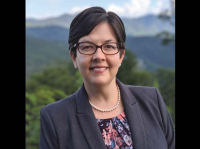Two Sparrows: Town WCU renames renovated collections facility in honor of Cherokee past
 Participants in WCU’s summer archeology field school work on the Norton Field site. WCU photo
Participants in WCU’s summer archeology field school work on the Norton Field site. WCU photo
Long before the creation of Western Carolina University, the state of North Carolina or the U.S. Constitution, the valley now known as Cullowhee bore the name Tali Tsisgwayahi — in Cherokee, it meant “Two Sparrows Town.”
Now, that name has returned to a portion of the 600-acre campus with the formal dedication of the Two Sparrows Town Archeological Collections Curation Facility, held Thursday, Dec. 6, at the facility on the ground floor of McKee Building.
“This facility is unique because it stands in the middle of the ancient town and holds collections of Two Sparrows,” Brett Riggs, who holds a doctorate and is the Sequoia Distinguished Professor of Cherokee Studies at WCU, told the approximately 75 people gathered for the event. “Dedicating this facility and naming it Two Sparrows Town, we are bringing that identity back to Western Carolina so that we can celebrate that collectively.”
A place in history
The renaming was the result of a full year of conversation and collaboration between the university and the tribe, with Tribal Council unanimously approving a resolution during its March 14 meeting to authorize the renaming and the proposed rendering of the Cherokee name.
According to the resolution, a series of letters that Assistant Principal Chief Charles R. Hicks wrote to future Chief John Ross in 1826 relate a migration story from the 1770s that concludes with the Cherokee settling at a place called the Two Sparrows, located near the head of the Tuckasegee River. Another elder giving testimony in the 1830s said that Two Sparrows was a holy place whose surrounding hills were said to contain large villages of immortals. Ethnographer James Mooney in 1887 recorded Cherokee sources who referred to the mound and ancient town on what is now WCU’s central campus as “a place typified by sparrows” — the places described by Mooney and Hicks appear to be the same and were located at the current site of WCU, the resolution states.
Related Items
“The mound that was the center of town was maybe 150 yards away from here at one time,” said Riggs.
The newly renamed facility, Tali Tsisgwayahi — it sounds like tahli gee squa ya hee — refers only to the ground floor of a single building on campus, but to tribal members who spoke at the dedication the name’s significance expands beyond the building’s physical boundaries.
“It just doesn’t mean a geographical location,” said Tom Belt, a member of the Cherokee Nation and retired coordinator of WCU’s Cherokee language program. “It’s a place in the history of our people. It’s a place in the history of our hearts and minds and it’s a place in the future of our children and grandchildren. It will always be that. It doesn’t matter if we change it to Cullowhee or Jackson County or the United States of America or North Carolina for more than 8,000 years. It has been Tali Tsisgwayahi, the Two Sparrows Place.”

Joyce Dugan, former Cherokee chief and current member of the Western Carolina University Board of Trustees, speaks at the dedication ceremony. Holly Kays photo
Uncovering the past
The history of relations between indigenous people and the American government is a sordid one, with few pleasant chapters. But Joyce Dugan, former Principal Chief of the Eastern Band of Cherokee Indians and a current member of the WCU Board of Trustees, said that both the tribe and the university are now benefiting from the positive relationship that the two entities have fostered in recent years, even as tribal members’ cultural awareness and political power have grown.
“Most of this university has been built over a Cherokee town,” she said. “We didn’t know it, and you didn’t know it, because back in the day it didn’t matter. But because of this (cultural) Renaissance or revolution, we know it now and we don’t allow it anymore. We don’t allow buildings to be put up without consultation with us and with other tribes as well. And so I’m happy today to see this because this is something I’ve hoped for, for many years, that there could be a better partnership between this university and the tribe.”
An example of this relatively new cultural awareness at work is the excavation of a 10-acre site on campus earlier this year, known as Norton Field. The university plans to cover it with fill dirt and level the surface to build intramural athletic fields, but first students at WCU’s summer archeology field school examined four rectangular excavation pits to extract and catalogue any elements of Cherokee history that might be found there.
In total, the students and faculty working the site recovered 1,465 ceramic shards and 1,290 chipped stone artifacts. An additional 22 possible cultural features were identified, including 18 possible posts, three possible pit features and a large rock cluster or earth oven. Five of the 22 features, including the rock cluster, were excavated.
The work is not done.
“Ongoing excavations are being conducted by TRC (Environmental Corporation) and Western Carolina archeologists and students and have revealed evidence of multiple house patterns and features,” reads a research poster hanging outside the collections center.
The poster concludes that the site is likely eligible for the National Register of Historic Places and that findings suggest domestic structures and graves may be present in the study area.

Students make use of the study room at the Two Sparrows Town Archeological Collections Curation Facility. Holly Kays photo
‘We are still here’
The renaming follows an extensive renovation of the collections facility funded through a $175,000 grant from the U.S. Forest Service. Completed last year, the renovation increased the facility’s capacity by 80 percent, resulting in a climate-controlled environment where Cherokee archeological collections can be curated, cataloged, organized, conserved and studied in accordance with federal and tribal standards. By accepting the Forest Service grant, WCU became the official repository for Forest Service-owned collections related to the Trail of Tears, in addition to its many university-held artifacts.
“Here you will find objects from the Trail of Tears, which was the forced removal during the 1930s of the Cherokees from their homeland to what is known today as Oklahoma,” said Chancellor Kelli R. Brown. “And you will find items from a very recent archeological dig on campus near Norton Residence Hall, land that was once a corner of the historic Two Sparrows town. Western Carolina University is truly honored to be permitted to be a keeper of the largest collection of Cherokee-related materials in the Southeast, to be trusted with their care and safekeeping, and to be able to share these significant items with others both far and near.”
Since 1987, the Trail of Tears National Historic Trail within the National Park Service has commemorated key places and events along the route exiled Cherokee were forced to walk. Despite its undeniable significance in Cherokee history and central importance to the Trail of Tears tragedy, North Carolina wasn’t added to the historic trail until 2009. That addition — much of which travels through Forest Service lands — combined with WCU’s robust Cherokee studies program formed the basis for cooperation between the university and the Forest Service.
“One of the items that we came to an agreement upon was that we needed a better place to house the artifacts, and that we knew that we were running out of space at Western Carolina University,” said Melissa Twaroski, coordinator for the Trail of Tears on national forest lands for the Forest Service’s Southern Region. “This area is kind of a linchpin in the Trail of Tears, particularly here in the heart of the homeland of the Cherokee people.”
In WNC, the Trail of Tears followed routes that were in many cases thousands of years old — well-worn paths through the mountains that Cherokee people walked for millennia and are still identifiable today.
“To be out there with some of the representatives from those federally recognized Cherokee tribes when they’re there for the first time, particularly the folks from out in Oklahoma who haven’t been back East — they see it and then say, ‘This is real. This is where our grandmothers walked,’” said Twaroski. “It’s really stirring and moving.”
Belt can speak personally to the importance of that connection, and to the significance a few words in the name of a facility — Tali Tsisgwayahi — can have to a people.
“I cannot and so I will not speak for the Eastern Band. I can’t. We have people here who are qualified to do that, who actually can speak for them. I can’t even speak for the Cherokee Nation or the United Kituwah Band in Oklahoma. I haven’t been given that permission,” said Belt. “But I can speak for my grandmothers and my grandfathers who aren’t here today and who lived in this town, and I would say to you that to hear those words and for it to be acknowledged in any language means that they haven’t gone away. It means that our culture has not died. And it means that we are still here because we remember them, and we remember what they called this place.”









